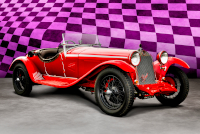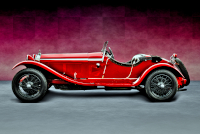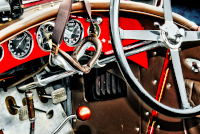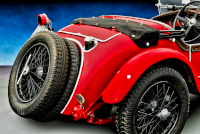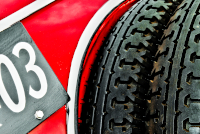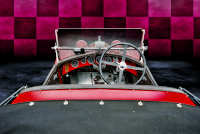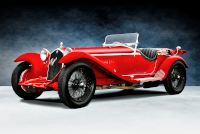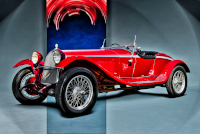Location:
St. Michaels Concours d'Elegance, 2011
Owner: Nancy & John Kendall | Marion, Massachusetts
Prologue:
I wavered, did not know whether to publish this profile before identifying the chassis and providing a decent story for the car. However, where the 6C series is concerned, we can see a little more of it, particularly the profile and the cockpit. And for a more thorough description, we can reference 6C 1750 Gran Sport #8513045, which covers the broader scope in sufficient detail.
Note that this 6C Alfa hails from the same venue as 8C 2300 Corto Mille Miglia #2111015. A cloudy St Michaels afternoon, supple tones on the waterfront, provides even light that translates easily to an illustrated format. Back then it seemed like old Alfas popped up every show, and yet these were good days. St Michaels took a best-of approach in its early years and focused on the classic era exclusively. And the Alfa Romeo centennial had just passed in 2010. So everyone wanted to see rare red cars. Thinking of the broader portfolio, I find it worthwhile to include another 6C just to take in a few more perspectives. Because sufficiency doesn't court passion. So if we wish to discuss Alfa Romeo in passionate terms, then we cannot be so easily sated.
- - - - - - - - - -
► Image Source: Nikon D200 (10.2 MP) | Image Source 6 by E, illustrated by the author.
References:
- Automobile Quarterly, Volume 7, Number 2, "Alfa Romeo 6C 1750" by Michael Lorrimer, The Kutztown Publishing Company, Inc., Kutztown, PA, page 200
- Czap, Nick. "Museo Storico Alfa Romeo: The catalogue" Giorgio Nada Editore, Milano, Italia. 2015, page 55
- Heseltine, Richard with photographs by Michel Zumbrunn. "Italian Auto Legends, Classics of Style and Design" Merrell Publishers Limited, London, UK. 2006, page 55
- FCA Heritage: An interesting project we'll watch, Heritage surveys this Series IV 6C 1750 Gran Sport. I like the photography method in this story, quite different from my style—very short lens, cropped, but picks at some neat details inside and out.
At present, look toward chassis #8513045 and #10814368 for more expressive prose on the Series IV and Series V 6C Alfa, respectively. We're fortunate to wander through a number of examples, this car being the sixth 6C published to the portfolio. But the entry lives for the benefit of visual expression, rather than recapitulating a story covered countless times thus far.
Presume for the time being that Alfa Romeo delivered this chassis to England—low-hanging fruit based on the 'GB' plate fixed to the right rear tail light assembly. Period registration is FSJ 403, though no information surfaces in the Alfa Romeo registries I've searched. But given the time between the event and publication, we might expect further changes that obscure identification. For context, we can say that this car falls within the fourth series, which forms the bulk of the Gran Sport spiders, up-rated from the Series III Super Sport. Details vary among the lot, though none we can link conclusively to this example.
Motor: 1,752 cc straight 6-cylinder, cast iron block, iron hemi-head | 65 mm x 88 mm | 5.0:1 compression
Valvetrain: DOHC, 2 valves per cylinder
Aspiration: Memini DOA dual-choke carburetor, Roots-type supercharger
Power: 85 bhp @ 4,500 rpm
Drivetrain: 4-speed gearbox, rear-wheel drive
Front Suspension: beam axle, semi-elliptic leaf springs, friction dampers
Rear Suspension: live axle, semi-elliptic leaf springs, friction dampers
Architecture: pressed steel ladder-frame chassis with aluminum body by Zagato of Terrazzano di Rho, Lombardia
Among many to clothe the 6C Alfa, Richard Heseltine writes, "it was Carrozzeria Zagato that produced the most elegantly proportioned and unfussy offerings." The term 'unfussy' is perhaps most appropriate, and not at all unique, with a style similar to the lesser known OM 665.
Kerb Weight: 920 kg (2,028 lbs)
Wheelbase: 2,745 mm (108.1 inches)
0-60: about 14.0 seconds
Top Speed: 145 km/h (90 mph)
Etymology:
'6C 1750' refers to the motor configuration, a straight 6-cylinder of about 1.75 litre displacement (1,752 cc). 'Gran Sport' refers to the fourth series update of Alfa Romeo's well tested Super Sport platform, with the notable addition of a roots supercharger. The term 'spider' descends from the carriage trade, which in motorcar parlance came to refer to open sports cars. 'Zagato' is the Milanese coachbuilder who provided the aluminum coachwork.
Figures:
From 1929 to 1933, Alfa Romeo built a reported 2,579 examples of the 6C 1750, doing so in six different configurations over four successive development series. In truth, the 6C is a model split across the 6C 1500 (Series 1 and 2), and the 6C 1750 (Series 3 through 6). These figures make the 6C 1750 a volume production sports car at a time when the thing itself does not exist. Of the total production figure, Alfa Romeo built 257 Gran Sport Spiders, all from 1930 to 1933. Of these, 213 comprise the 4th and 5th series from 1930 to 1932, whereas the 44 6th series cars are slightly more refined. Zagato most often provided the coachwork.
Series Speak: Zagato Styling Consistent with the Fourth Series 6C 1750
Without identifying the chassis, I cannot verify the originality of the coachwork. But the finish is recognizably of the fourth series Zagato spider. Broad running boards with seven chrome strakes fit narrowly over the wheels, more so than #8513045, hinting at a fifth series stance. The trapezoidal vent fits a Series IV, with cut-down doors in typical Zagato style. (Chassis #8513045 is more uncommon in this respect.) The fascia features a grille screen and indicators for roadway use, but omits a horizontal stabilizer bar. More uncommon is the cowl between the dumb irons. At a glance, cowls appear rarely, often with a deeper in-sweep design. This cowl fits fully over the rails with four louvres, though it is not extraordinarily singular. From the flank and through the tail, smooth chrome trim lines the doors, deck hatch, and spares compartment.
Quarter perspectives look athletic, hinting at a modern sports car. In profile, we see the cart-like platform with its wheels separated to the corners. For all its overhead-cam modernity, the 6C is partly a ride-on exercise, as opposed to riding within. The simple boards and perfunctory top take direction from the antique era, only that the stance has lowered and the capacity reduced to a modern standard of power output efficiency.
Pundits will speak at length of the fundamental beauty of Zagato's 6C 1750 coachwork, though the sense of line and proportion is a matter of basic reproduction. For instance, the contemporary OM 665 wears similar skin.
Pedal Treads: 6C 1750 Interior Appointments
Another look at the footwell, we see the clutch (left) and brake (right) with the round throttle pedal in the middle. On the dashboard, Jaeger gauges, in this case set into a color-matched red panel. Brown leather trim extends throughout and onto the door sills, echoed nicely by the period goggles.
Last Updated: Mar 26, 2025

